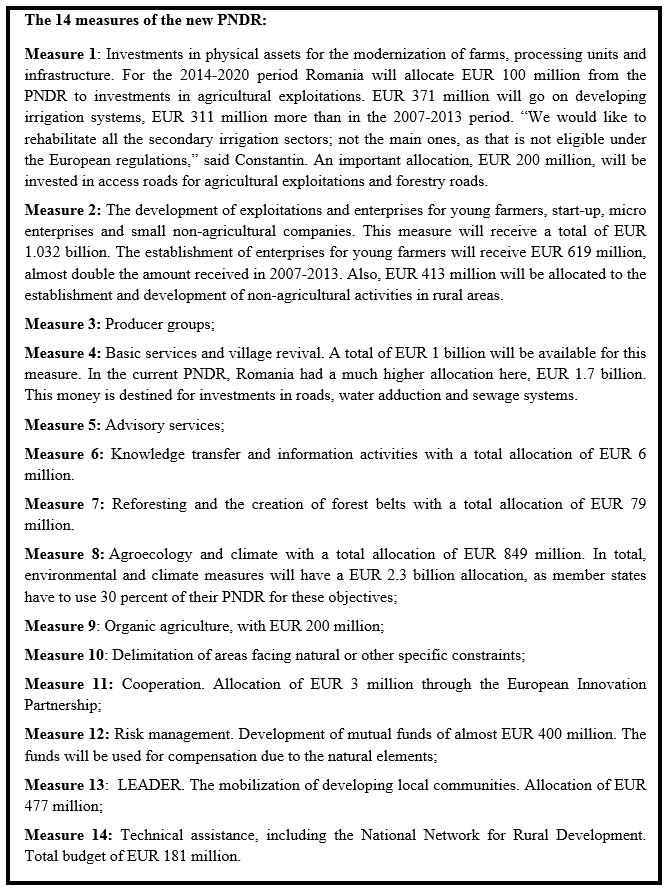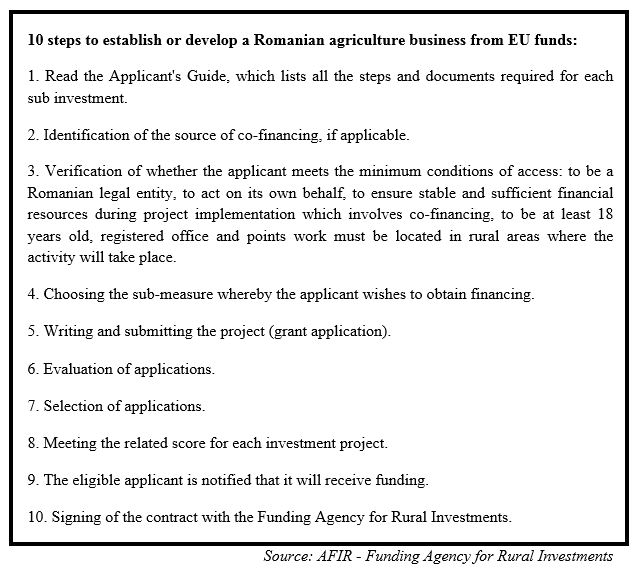:quality(80)/business-review.eu/wp-content/uploads/2015/09/entrepreneurship-in-agriculture.jpg)
Accessing and absorbing European funds for agriculture is the greatest challenge for the Romanian public administration, business environment and non-governmental institutions, according to recent research by the University of Agricultural Sciences and Veterinary Medicine of Banat, Faculty of Agricultural Management. Making use of European funds is an opportunity to boost the country’s economic growth, since it would mean an annual capital input of up to 5 percent of the gross domestic product, adds the same source.
Laura Grigore
The number of the projects submitted nationally for one branch of the new National Rural Development Programme (PNDR) 2014-2020 has reached 1,215, worth almost EUR 87 million, according to data sent to Agerpres by the Agency for Rural Investment Funding (AFIR).
The new PNDR 2014-2020 on agricultural development includes 14 financing measures and total funds of EUR 9.363 billion, including over EUR 8 billion of European funds, and a EUR 1.347 billion national contribution. Young people can launch projects in the field worth up to EUR 50,000 for a period of five years.

According to the European Commission, 24 additional rural development programs were approved to improve the competitiveness of EU agriculture, rural development and climate protection, and strengthen the economic and social structures of rural communities through to 2020.
“It is estimated that the adopted programs will create 40,000 jobs in rural areas and about 700,000 training places to encourage innovation, transfer of knowledge, more sustainable agricultural practices and more powerful businesses in the countryside. It provides a grant worth EUR 27 billion in the EU budget co-financed by other public funds at national / regional level and / or private funding,” said officials.
Phil Hogan, Commissioner for EU Agriculture and Rural Development, stated: “As discussed during my recent visit to Romania, the PNDR has the potential to provide a major boost for rural areas. The Romanian PNDR puts a particular focus on farm modernization and restructuring to improve competitiveness in the agricultural sector, on conserving Romania’s rich biodiversity and promoting environmentally-friendly farming practices, alongside investments to develop the broader rural economy and improve quality of life in Romania’s villages.”
Much of the European funds allocated from the PNDR are aimed at young people who want to develop businesses in the country. Although such an initiative sounds good on paper, in reality it faces numerous problems, say commentators. They include, according to Calin Nutu, AFIR director, land ownership, as a project financed with EU money requires clear ownership of the property (where, in the absence of a proper land registry, Romania is at a big disadvantage) and compliance with the business plan originally submitted.
Potential beneficiaries are dissatisfied with the “excessive bureaucracy” of the conditions of money access and eligibility criteria. Laurentiu Baciu, president of the League of Associations of Agricultural Producers in Romania (LAPAR), commented in a press conference, “. Large projects can access up to EUR 500,000, while small 5 hectare projects can take up to EUR 2 million. These projects do nothing with the money and don’t have co-financing.”
George Turtoi, general director at the Payments Agency for Rural Development and Fisheries (ARDRP), which carries out the implementation of the National Rural Development Programme, said that sporadic non-reimbursable European financing investments are not encouraged, but the aim is to create a viable village economy that offer residents the prospect of a better life.
“These investment projects are actually funded by the PNDR to develop rural areas. Therefore the decision to write and submit an investment project must be supported primarily by established knowledge of the domain where the investor desires to invest. This must be accompanied by knowledge of procedures both for accessing grants and for actual implementation of the project. Even if the business starts with European support, in the end it is a personal affair which should be viable, sustainable and enduring,” added Turtoi.
Meanwhile, Daniel Constatin, agriculture minister, told media representatives that he hopes more cooperative farms will appear in the coming years. “We want to convince farmers to make a next step in agriculture or business development,” added Constantin. More Romanian farmers have been registering their business in recent months, as this has become a mandatory condition for those who want to get EU funds for agriculture from 2015. Romanians registered over 6,000 new businesses in the agriculture sector in the first five months of 2015, three times more than in the same period of 2014, according to official data from the National Trade Registry’s Office (ONRC). The 4,000 new businesses in agriculture accounted for 85 percent of the growth in new business registrations over the January-May period. A total of 51,400 new enterprises registered in the first five months of 2015, up by 4,700 (or 10.3 percent) compared to the same period of 2014.
The first step for an entrepreneur seeking to submit a project is analyzing the annexes to the Applicant’s Guide which show the agricultural potential (for vegetables, as well as animals) of the location of the intended investment. For the main animal and vegetable species (with or without irrigation systems) their potential in every city or village in Romania is defined as low, medium or high. Investments in areas with low potential are still eligible, but only investments in areas with a medium or high potential receive points within the selection criteria, so they have a much higher chance of getting financed. To find out if they can benefit from these funds, applicants who already own a farm should calculate its economic size, expressed in Euros, which means its capacity to obtain a reasonable income with the species of animals or vegetables in that farm. They must use the standard production coefficients cited by the Financing Agency for Rural Investments in the Financing Application Form.

The main condition is the farm must have an economic size of minimum EUR 8,000 standard production. For cereals, a minimum of EUR 8,000 standard production means a minimum of approximately 12 hectares of corn or colza, 15 hectares of common wheat or sunflower, 20 hectares of rye or 26 hectares of oat. As for field vegetables (including watermelons and strawberries), the minimum surface is a little over one hectare, and for vegetables cultivated in protected environments (including watermelons and strawberries) the minimum surface is about 2,000 square feet.
For animal farmers, EUR 8,000 standard production means 8 milk cows, almost 160 sheep (gestating), 20 heavy pigs, 1,800 broilers or a minimum of 153 bee families. Owners of farms below this minimum size cannot access the program, but are encouraged to associate with others as cooperatives or production groups – forms supported by the new NPRD through selection points and supplementary co-financing rates.
In Romania, agriculture has a gross added value of 6 percent, much higher than the average 1.7 percent in the EU, but the agricultural sector is still ‘backwards’ compared to other European states. Constantin claims that the country can provide food for a population of 36-37 million, much more than the actual population of Romania, which is 20.1 million.
Over 2007-2013, 85,608 projects were funded by the PNDR worth about EUR 5.7 billion, or nearly 92 percent of the funds allocated to Romania through this project.
The measures of the National Rural Development Programme 2014-2020 respect the provisions of the EU’s Common Agricultural Policy, which has two directions: Pillar 1 – direct payments and Pillar 2 – rural development.
For investments in agricultural exploitations 104 projects worth EUR 44,048,398 were submitted, while for support to the young farmers there are 901 applications worth EUR 38,330,000.
According to AFIR data, another sub-measure has received 30 applications of EUR 1,720,000, with support for setting up non-agricultural activities in rural areas. Likewise, for the development of exploitations and enterprises, two applications worth EUR 395,460 were tabled.
For the sub-measure on the training support for the drafting of local development strategies 178 applications worth EUR 2,5 million were submitted.



:quality(80)/business-review.eu/wp-content/uploads/2024/04/Vlad-Dragulinescu.png)




:quality(80)/business-review.eu/wp-content/uploads/2024/02/IMG_6951.jpg)

:quality(80)/business-review.eu/wp-content/uploads/2024/04/COVER-1.jpg)



:quality(80)/business-review.eu/wp-content/uploads/2024/04/cover-april.jpg)
:quality(50)/business-review.eu/wp-content/uploads/2023/03/business-review-buy-google-reviews.webp)
:quality(50)/business-review.eu/wp-content/uploads/2024/04/Rafaela-Nebreda-fondator-Imoteca.jpg)
:quality(50)/business-review.eu/wp-content/uploads/2024/04/Slide1.png)